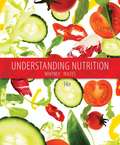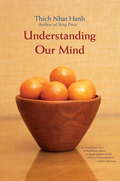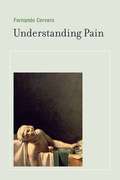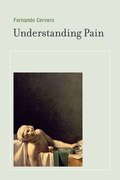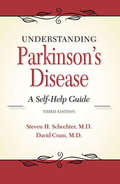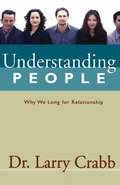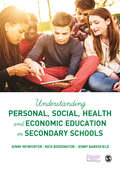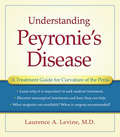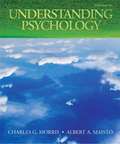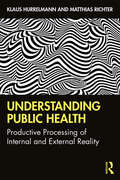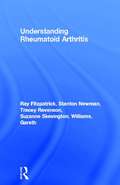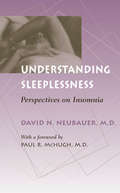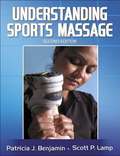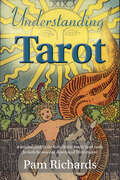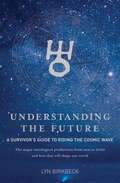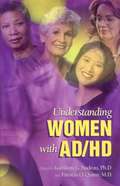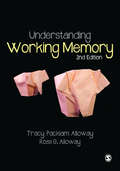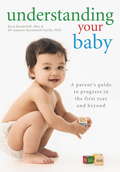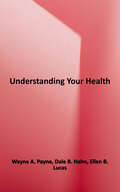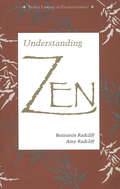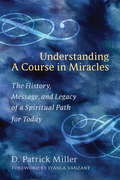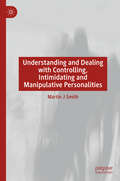- Table View
- List View
Understanding Nutrition: Fourteenth Edition
by Ellie Whitney Sharon Rady RolfesMore than one million readers make UNDERSTANDING NUTRITION the best-selling introductory nutrition book on the market today! Now in its 14th Edition, this book maintains the quality and support that discerning readers demand in nutrition applications and science that are ideal at introductory levels. New and updated topics refresh every chapter, along with the emphasis on active learning, assignable content, and integrated resources that help you advance your knowledge and career. Connecting with you through an approachable writing style, UNDERSTANDING NUTRITION, 14th Edition includes twenty chapters on topics such as diet planning, macronutrients, vitamins and minerals, diet and health, fitness, life span nutrition, food safety, and world hunger, among others. Combined with a carefully developed art program and a variety of interactive activities, UNDERSTANDING NUTRITION, 14th Edition continues to set the standard for introductory nutrition texts.
Understanding Our Mind: 51 Verses on Buddhist Psychology
by Thich Nhat HanhA finalist for the 2001 Nautilus Award, Understanding Our Mind, is Thich Nhat Hanh's profound look at Buddhist psychology with insights into how these ancient teachings apply to the modern world. Based on the fifty verses on the nature of consciousness taken from the great fifth-century Buddhist master Vasubandhu and the teachings of the Avatamsaka Sutra, Thich Nhat Hanh focuses on the direct experience of recognizing, embracing, and looking deeply into the nature of our feelings and perceptions. Presenting the basic teachings of Buddhist applied psychology, Understanding Our Mind shows us how our mind is like a field, where every kind of seed is planted--seeds of suffering, anger, happiness, and peace. The quality of our life depends on the quality of the seeds in our mind. If we know how to water seeds of joy and transform seeds of suffering, then understanding, love, and compassion will flower. Vietnamese Zen Master Thuong Chieu said, "When we understand how our mind works, the practice becomes easy."
Understanding Pain
by Fernando CerveroIf you touch something hot, it hurts. You snatch your hand away from the hot thing immediately. Obviously. But what is really happening, biologically--and emotionally? In Understanding Pain, Fernando Cervero explores the mechanisms and the meaning of pain. You touch something hot and your brain triggers a reflex action that causes you to withdraw your hand, protecting you from injury. That kind of pain, Cervero explains, is actually good for us; it acts as an alarm that warns us of danger and keeps us away from harm. But, Cervero tells us, not all pain is good for you. There is another kind of pain that is more like a curse: chronic pain that is not related to injury. This is the kind of pain that fills pain clinics and makes life miserable. Cervero describes current research into the mysteries of chronic pain and efforts to develop more effective treatments. Cervero reminds us that pain is the most common reason for people to seek medical attention, but that it remains a biological enigma. It is protective, but not always. Its effects are not only sensory but also emotional. There is no way to measure it objectively, no test that comes back positive for pain; the only way a medical professional can gauge pain is by listening to the patient's description of it. The idea of pain as a test of character or a punishment to be borne is changing; prevention and treatment of pain are increasingly important to researchers, clinicians, and patients. Cervero's account brings us closer to understanding the meaning of pain.
Understanding Pain: Exploring the Perception of Pain
by Fernando CerveroAn expert explores the nature of pain: why it hurts and why some pain is good and some pain is bad.If you touch something hot, it hurts. You snatch your hand away from the hot thing immediately. Obviously. But what is really happening, biologically—and emotionally? In Understanding Pain, Fernando Cervero explores the mechanisms and the meaning of pain. You touch something hot and your brain triggers a reflex action that causes you to withdraw your hand, protecting you from injury. That kind of pain, Cervero explains, is actually good for us; it acts as an alarm that warns us of danger and keeps us away from harm. But, Cervero tells us, not all pain is good for you. There is another kind of pain that is more like a curse: chronic pain that is not related to injury. This is the kind of pain that fills pain clinics and makes life miserable. Cervero describes current research into the mysteries of chronic pain and efforts to develop more effective treatments. Cervero reminds us that pain is the most common reason for people to seek medical attention, but that it remains a biological enigma. It is protective, but not always. Its effects are not only sensory but also emotional. There is no way to measure it objectively, no test that comes back positive for pain; the only way a medical professional can gauge pain is by listening to the patient's description of it. The idea of pain as a test of character or a punishment to be borne is changing; prevention and treatment of pain are increasingly important to researchers, clinicians, and patients. Cervero's account brings us closer to understanding the meaning of pain.
Understanding Parkinson's Disease: A Self-Help Guide
by David L Cram Steven H SchechterIf you've been told by your doctor, "You have Parkinson's disease," you probably found it difficult to hear those words. Such a diagnosis can be frightening and leave you filled with questions. How will it affect your life? What are your treatment options? These authors are uniquely qualified to understand your concerns. Steven Schechter, M.D., is a neurologist who has treated thousands of patients with Parkinson's disease, and David Cram, M.D., lived with the disease himself. Among the topics they cover are: diagnosis, symptoms and stages, the emotional side of PD—conquering fear and denial, choosing the right health care team, drug therapy—medications and how they work, surgical options, deep brain stimulation, the importance of exercise, coping with day-to-day problems, and care for caregivers.
Understanding People: Why We Long For Relationships
by Larry CrabbExploring the link between the spiritual and psychological, Crabb offers a vital lens on who we really are and what makes us tick in our relationships with people, God, and with ourselves. In three parts, this book first points us to the Bible as our source of insight into perplexing heart issues. Then it helps us come to grips with our brokenness as God's image-bearers, and it shows how we can reclaim our ability to reflect him in our growth toward maturity and healed relationships.
Understanding Personal, Social, Health and Economic Education in Secondary Schools
by Nick Boddington Jenny Barksfield Jenny McWhirterThis book provides an overview essential for a proper understanding of effective approaches to PSHE education in secondary education and the valuable role it can play in promoting the health and wellbeing of adolescents. Coverage includes: The importance and scope of PSHE education The theory and research evidence for effective practice in the secondary school School structures which support effective teaching and learning in PSHE education Assessment for, and of, learning in PSHE education The role of visiting experts in PSHE education Overlaps with pastoral and therapeutic support
Understanding Peyronie's Disease: A Treatment Guide for Curvature of the Penis
by Laurence A. LevineThe psychological and physical pain of Peyronie's disease is addressed with quiet sympathy in this overview of the most-asked questions urologists hear from patients being treated for its symptoms. The role of the disease in erectile dysfunction is clearly outlined, and such treatments as injections, ionospheres (EDMA), shock waves, stretching therapy, and topical medications are explained. For more debilitating cases, surgical approaches such as grafting, plication, and prosthesis implantation are discussed, with advice about seeking good medical evaluations in order to assess the surgical options. Interesting case studies are presented in the final chapter, and a glossary and list of resources are also included.
Understanding Psychology (9th Edition)
by Charles G. Morris Albert A. MaistoThis textbook presents a scientific, accurate, and thorough overview of the essential concepts of psychology in engaging language that the average reader can easily comprehend. Topics include the science of psychology, the biological basis of behavior, sensation and perception, states of consciousness, learning, memory, cognition and mental abilities, motivation and emotion, life-span development, personality, stress and health psychology, psychological disorders, therapies, and social psychology. For anyone who is interested in introductory psychology.
Understanding Public Health: Productive Processing of Internal and External Reality
by Matthias Richter Klaus HurrelmannThis book develops a new model of the genesis of health, on the basis of the interplay between genetic and environmental factors. Hurrelmann and Richter build upon the basic theories of health and the popular model of salutogenesis to offer a comprehensive interdisciplinary theory of health genesis and success: Productive Processing of Reality (PPR). The authors show that health is the lifelong dynamic process of dealing with the internal reality of physical and psychological impulses and the external reality of social and material impulses. To demonstrate this, the book is split into three interconnected parts. Part A analyses the determinants of health, providing an overview of the insights of current research and the impact of socioeconomic influences and gender on health. Part B covers public health, social, learning and coping theories, all of which understand health as an interaction between people and their environment. Part C draws on these four theories to outline PPR, stressing the interrelation between physical and mental constitution and the demands of the social and mental environment, and suggesting strategies for coping with these demands during the life course. Understanding Public Health: Productive Processing of Internal and External Reality will be valuable reading for students and researchers in psychology, sociology, educational science, public health and medical science, and for policymakers in public health.
Understanding Rheumatoid Arthritis
by Gareth Williams Ray Fitzpatrick Stanton Newman Tracey Revenson Suzanne SkevingtonRheumatoid arthritis (RA) is a major cause of disability affecting about 1% of the population. Although much effort has been expended on research into the causes and cures of RA, little progress has been made. The focus of treatment in RA is on reducing the disabling consequences of the disease and controlling the symptoms. Understanding Rheumatoid Arthritis examines the nature of RA and its symptoms of pain and stiffness. The role of health care professionals and the individual's encounters with the doctor are important to understand as these experiences influence the individual's behaviour and understanding of their RA. This book will be an invaluable aid to the considerable number of people who suffer from rheumatoid arthritis, their families, carers and all health professionals involved in its treatment.
Understanding Schizophrenia: A Guide to the New Research on Causes and Treatment
by Richard S. E. Keefe Philip D. HarveyA state-of-the-art title, this handbook describes the most up-to-date knowledge on cognition in schizophrenia. Cognition is perhaps the most critical aspect of the schizophrenic illness. For the first time, the authors assess the importance of cognition as an independent symptom domain, including an analysis of the costs of impairment. They focus on all the essential features of cognition in schizophrenia and discuss the clinical implications of these deficits in the everyday life of patients. New me...
Understanding Sex and Relationship Education, Youth and Class: A Youth Work-Led Approach
by Sharon ElleyThis book sets out an original Youth Work-based SRE programme and explores how a range of socioeconomic, cultural and sexual norms, values and attitudes differently shape decision-making on sex, intimacy and future plans across different contexts.
Understanding Sleeplessness: Perspectives on Insomnia
by David N. NeubauerSeemingly the most natural and necessary of pursuits, a good night's sleep eludes a remarkable number of people—up to 50 percent of the general population, according to studies, while 10 to 15 percent suffer from severe or chronic sleep disorders. Because the causes and nature of sleeplessness are so many and varied—and often as elusive as sleep itself—the diagnosis and treatment require a flexible, multifaceted approach—and this is precisely what David N. Neubauer lays out in Understanding Sleeplessness.Building on the "four perspectives" conceptualized by McHugh and Slavney in The Perspectives of Psychiatry, Neubauer offers a much-needed explanation of the diverse ways of understanding what insomnia is and what should be done about it. He begins by surveying what is currently known about the mechanisms of "normal sleep" and, in this light, describing the problems of defining, assessing, and measuring insomnia. Drawing examples from patients studied at the Johns Hopkins Sleep Disorders Center, Neubauer then applies each of the four perspectives—diseases, dimensions, behaviors, life stories—to the varied kinds and degrees of sleeplessness. Finally, calling on the full range of perspectives on insomnia, he outlines an integrated approach to evaluation and treatment. His work will be of great interest and value to those who study and treat sleeplessness and to those who wish to understand this widespread and vexing problem.
Understanding Sports Massage (2nd edition)
by Patricia J. Benjamin Scott P. LampUnderstanding Sports Massage is ideal for sport professionals and students in training programs. The book explains massage techniques in detail and describes the procedures involved in conducting effective sports massage sessions.
Understanding Tarot: A detailed guide to the Rider-Waite tarot cards, for both the new and experienced tarot student and reader.
by Pam RichardsAt the heart of Pam Richards’ new book Understanding Tarot is a detailed guide to the imagery and symbolism of each of the 78 cards in the tarot deck. Both the upright and reversed meanings of each card are given. For those new to tarot, keywords for each card are displayed in bold-italic text. This book uses as its reference point the classic tarot deck known as ‘Rider-Waite-Smith’, which was designed by Arthur Edward Waite and then drawn and brought to life by Pamela Colman Smith in 1909. Readers who wish to learn more about the images of this extraordinary deck will find this book very helpful. In addition, the book includes an ‘In a Nutshell’ section for each card, which allows it to be used with any set of tarot cards. Understanding Tarot is intended to be a companion for all tarot students, whether they are completely new to the subject or an experienced enthusiast looking to broaden their view of this wonderful deck of cards. Whether you wish to understand each card in detail or use them for psychic development, this book has you covered.
Understanding The Future
by Lyn BirkbeckThe next dozen years are set to be the most momentous of our lives. As humanity stands at the crossroads between a continued descent into dark materialism and the spiritual path back to the light, a great cosmic event is about to force this elemental choice. This astonishing illustrated astrological analysis shows that the present alignment of Uranus and Pluto with the Earth has set in motion a powerful Planet-Wave that will peak in 2012, heralding a period in which we face a unique opportunity to forge our destinies. Drawing a compelling analogy with quantum physics, this theory sets out the ways in which we can ride the wave by looking back into history at similar moments from the past.
Understanding Women With AD/HD
by Kathleen G. Nadeau Patricia O. QuinnUnderstanding Women with AD/HD is designed to be a practical and readable guide for women at any age, with special chapters focusing on different stages of life.
Understanding Working Memory
by Tracy Packiam Alloway Ross G AllowayWorking memory is how your brain stores information for a short period of time and how much you can fit on this 'post-it note' hugely influences how well you do at school and beyond. Understanding working memory means you will be able to better support children's learning and concentration. This can be particularly useful to children with conditions such as dyslexia, ADHD and autistic spectrum disorders, where poor working memory is thought to be an underlying factor. New to this edition are: · A new chapter on emotional difficulties and working memory · A clear chapter structure which looks at the what, where, why and how for every difficulty. · More information on how to work with younger children This book will make sure you are able to spot problems early, work with children to improve their working memory and ensure they reach their full potential. Tracy Packiam Alloway is an award-winning psychologist based at the University of North Florida Ross Alloway is the CEO of Memosyne Ltd, a company that brings cutting-edge scientific research to parents.
Understanding Your Baby: A parent's guide to early child development
by Annette Karmiloff-Smith Kyra KarmiloffBabies arrive in the world already equipped with many skills, reflexes and instincts that help them adapt to and influence their environment as well as the people who fill it. The mother-and-daughter team of Kyra Karmiloff, a research psychologist, and Dr Annette Karmiloff-Smith, a professorial research fellow at the Developmental Neurocognition Lab at Birkbeck College, University of London, 'translate' the latest scientific findings on infant behaviour, the development of gross and fine motor skills and intelligence, and how infants produce language and experience the social world, as well as offering helpful tips and suggestions about how parents can positively influence their child's journey towards independence.
Understanding Your Baby: A parent's guide to early child development
by Annette Karmiloff-Smith Kyra KarmiloffBabies arrive in the world already equipped with many skills, reflexes and instincts that help them adapt to and influence their environment as well as the people who fill it. The mother-and-daughter team of Kyra Karmiloff, a research psychologist, and Dr Annette Karmiloff-Smith, a professorial research fellow at the Developmental Neurocognition Lab at Birkbeck College, University of London, 'translate' the latest scientific findings on infant behaviour, the development of gross and fine motor skills and intelligence, and how infants produce language and experience the social world, as well as offering helpful tips and suggestions about how parents can positively influence their child's journey towards independence.
Understanding Your Health
by Dale B. Hahn Wayne A. Payne Ellen B. LucasThis book offers an exciting and practical approach to the teaching of the traditional content areas of personal health. Its two key themes - the six dimensions of health and the five developmental tasks - help students apply the text's content to their own lives, by improving their decision-making skills. The strength of the Understanding Your Health narrative includes its appeal to both traditional and non-traditional students, particularly the special attention it pays to students over age 25 who have returned to college. <p><p>In addition, among its many health assessment activities, Understanding Your Health includes one of the most comprehensive health assessments found in any personal health textbook - a great tool for establishing a health baseline for students. The companion Online Learning Center (website) offers a wealth of pedagogical and assessment features, including quizzes, Internet activities, downloadable MP3s, and more.
Understanding Zen
by Benjamin Radcliff Amy Radcliff"The authors of this book, who both have university affiliations, present Zen as a "secular doctrine without any necessary relationship to Buddhism or Eastern culture." Some of the seven chapters deal with such concepts as reason, paradox, meaning, and existence and how they relate to Zen. Others explore successfully the origin of Zen, the practice of meditation, and the social implications of Zen. The authors also investigate the Taoist and Buddhist ideas preceding Zen and relate it to Freudian psychology, anarchism, and the dualistic truths of the scientific method. Though this well-done study is accessible to informed lay readers, it is more suitable for academic libraries."--Library Journal
Understanding a Course in Miracles
by Iyanla Vanzant D. Patrick MillerThis comprehensive introduction to the grassroots phenomenon A Course in Miracles covers the book's role in America's changing spiritual landscape, investigates its origins and history, and explains its principal tenets and philosophies. Weaving together extensive research and student perspectives, journalist D. Patrick Miller sheds light on the provocative and oft-misunderstood text. An examination of the teachings and influence of A Course in Miracles, one of the most popular and controversial texts in contemporary spirituality. With a new foreword by Iyanla VanzantCovers common questions, such as What exactly is the Course? Is it Christian, Buddhist, New Age, or something else entirely? How did the author channel the message? More than two million copies of A Course in Miracles available worldwide in 19 languages, with thousands of study groups devoted to it. From the Trade Paperback edition.
Understanding and Dealing with Controlling, Intimidating and Manipulative Personalities
by Martin J SmithThis book will examine at individuals who control, intimate, and manipulate in work, home, family, and social environments, using robust Psychological theory to comprehend and successfully tackle those who exhibit these behaviours. The focus of this book will be to look at general Personality theory together with more specific focus on the Dark Triad of personality traits and, from the Five Factor Model, the domain of Agreeableness vs Antagonism. This approach will build a greater understanding of a much broader form of controlling intimidating and manipulative personality type. The book will include both useable techniques as well as self-reflection exercises the reader can use or pass on to students, clients and service users. This book is based on a programme the author has been teaching for over twelve years to a range of audiences across a variety of roles and has also been highlighted frequently in the press over the past decade.
